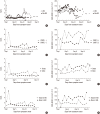Renal Complications and Their Prognosis in Korean Patients with Middle East Respiratory Syndrome-Coronavirus from the Central MERS-CoV Designated Hospital
- PMID: 26713056
- PMCID: PMC4689825
- DOI: 10.3346/jkms.2015.30.12.1807
Renal Complications and Their Prognosis in Korean Patients with Middle East Respiratory Syndrome-Coronavirus from the Central MERS-CoV Designated Hospital
Abstract
Some cases of Middle East Respiratory Syndrome-Coronavirus (MERS-CoV) infection presented renal function impairment after the first MERS-CoV patient died of progressive respiratory and renal failure. Thus, MERS-CoV may include kidney tropism. However, reports about the natural courses of MERS-CoV infection in terms of renal complications are scarce. We examined 30 MERS-CoV patients admitted to National Medical Center, Korea. We conducted a retrospective analysis of the serum creatinine (SCr), estimated glomerular filtration rate (eGFR), urine dipstick tests, urinary protein quantitation (ACR or PCR), and other clinical parameters in all patients. Two consecutive results of more than trace (or 1+) of albumin and blood on dipstick test occurred in 18 (60%) (12 [40%]) and 22 (73.3%) (19 [63.3%]) patients, respectively. Fifteen (50.0%) patients showed a random urine ACR or PCR more than 100 mg/g Cr. Eight (26.7%) patients showed acute kidney injury (AKI), and the mean and median durations to the occurrence of AKI from symptom onset were 18 and 16 days, respectively. Old age was associated with a higher occurrence of AKI in the univariate analysis (HR [95% CI]: 1.069 [1.013-1.128], P = 0.016) and remained a significant predictor of the occurrence of AKI after adjustment for comorbidities and the application of a mechanical ventilator. Diabetes, AKI, and the application of a continuous renal replacement therapy (CRRT) were risk factors for mortality in the univariate analysis (HR [95% CI]: diabetes; 10.133 [1.692-60.697], AKI; 12.744 [1.418-114.565], CRRT; 10.254 [1.626-64.666], respectively). Here, we report renal complications and their prognosis in 30 Korean patients with MERS-CoV.
Keywords: East Respiratory Syndrome-Coronavirus; Middle; Prognosis; Renal Complication.
Conflict of interest statement
Figures


References
-
- Zaki AM, van Boheemen S, Bestebroer TM, Osterhaus AD, Fouchier RA. Isolation of a novel coronavirus from a man with pneumonia in Saudi Arabia. N Engl J Med. 2012;367:1814–1820. - PubMed
-
- Memish ZA, Zumla AI, Al-Hakeem RF, Al-Rabeeah AA, Stephens GM. Family cluster of Middle East respiratory syndrome coronavirus infections. N Engl J Med. 2013;368:2487–2494. - PubMed
-
- Guery B, Poissy J, el Mansouf L, Séjourné C, Ettahar N, Lemaire X, Vuotto F, Goffard A, Behillil S, Enouf V, et al. MERS-CoV study group. Clinical features and viral diagnosis of two cases of infection with Middle East Respiratory Syndrome coronavirus: a report of nosocomial transmission. Lancet. 2013;381:2265–2272. - PMC - PubMed
MeSH terms
Substances
LinkOut - more resources
Full Text Sources
Other Literature Sources
Research Materials
Miscellaneous

